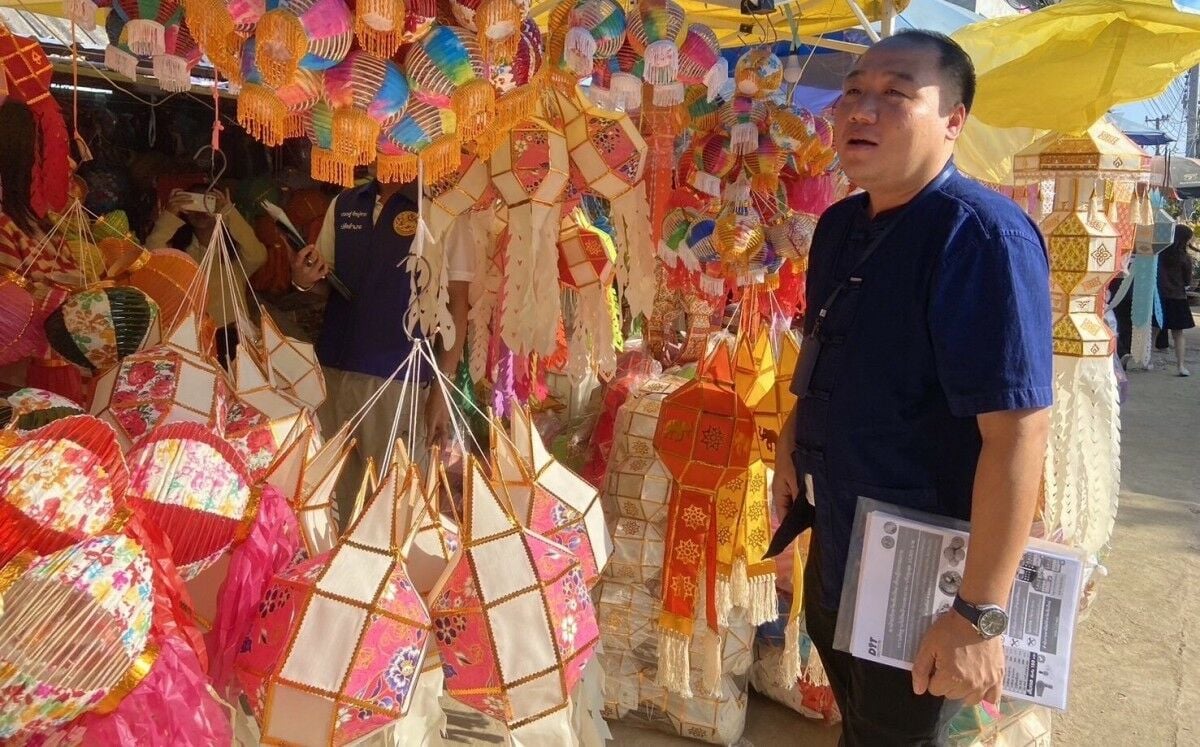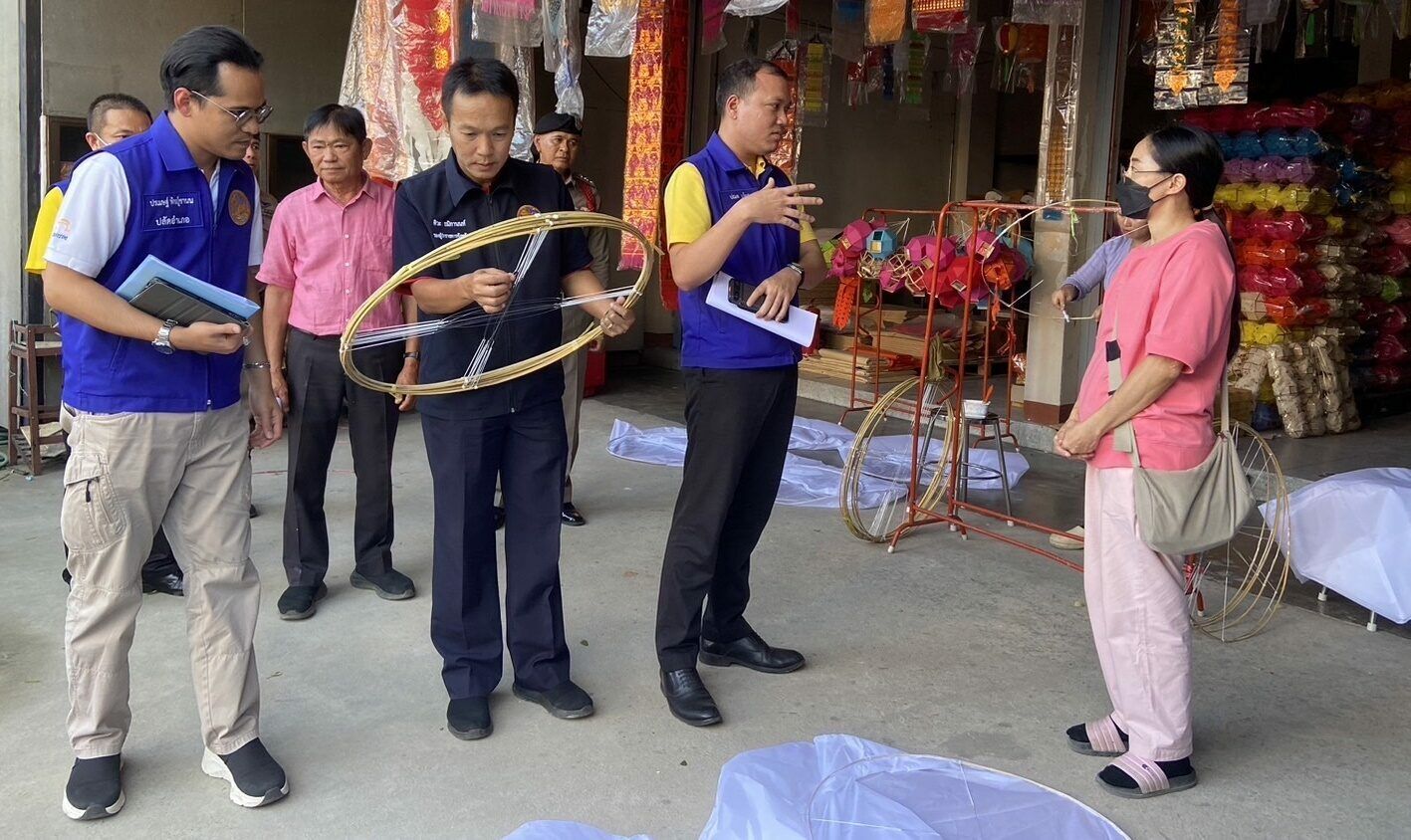Chiang Mai ‘grounds’ Yi Peng Festival lanterns to keep skies safe

Chiang Mai reinforced strict measures against the release of sky lanterns during the Yi Peng Festival to protect air traffic, particularly in six districts identified as high-risk areas. The release of lanterns outside these zones is permitted for only two days, with heavy penalties for violators.
The Deputy Governor of Chiang Mai, Siwa Thamikanont, along with the Chiang Mai Provincial Industry Office and local officials, has been actively engaging with lantern vendors to ensure compliance with safety standards.
They conducted inspections at three locations: a fuel supply for lanterns in Nong Tong, Hang Dong district; Racha Lantern Shop in Nong Phueng, Saraphi district; and a community area near Wat Muang Sart Luang, Nong Hoi, Mueang Chiang Mai district. These efforts align with Chiang Mai’s safety measures for the Yi Peng Festival this year.
Siwa emphasised the province’s commitment to public safety during the festival. Chiang Mai’s administrative office, alongside relevant agencies, has taken steps to educate local lantern vendors on adhering to the legal measures and understanding the province’s designated air safety zones.
Specific areas have been demarcated where the release of sky lanterns is strictly prohibited.
These include all subdistricts within Mueang Chiang Mai and Hang Dong, specific subdistricts in Saraphi such as Khua Mung, Don Kaeo, San Sai, Tha Wang Tan, and Nong Phueng, as well as Nong Han in San Sai district, Don Kaeo, Mueang Kaew, Rim Tai, Mae Sa, Rim Nuea in Mae Rim district, and Thung Tom in San Pa Tong district.
These areas are within the aviation radius, necessitating heightened restrictions.

In areas outside the specified air safety zones, lanterns can be released, but only with prior approval from the district officer, which must be sought 30 days in advance. This year, 62,000 lanterns have been officially sanctioned.
According to a 2020 provincial decree, lanterns may only be released on two specific days, November 15 and 16, between the hours of 7pm and 1am. The lanterns must comply with standard M.P.O.C. 808/2552, made from natural materials, with a diameter not exceeding 90 centimetres and a height not exceeding 140 centimetres. They must be released in areas where permission has been obtained.
Those who release lanterns without permission face imprisonment of up to five years, a fine of up to 200,000 baht, or both. If a lantern causes a fire, the penalties increase to a maximum of seven years imprisonment and a fine of up to 140,000 baht, or both.
The measures are part of a concerted effort by Chiang Mai authorities to balance cultural traditions with safety precautions, ensuring the Yi Peng Festival can be enjoyed without compromising public safety or air traffic operations.
The festival, renowned for its beautiful sight of countless lanterns illuminating the night sky, continues to draw attention both locally and internationally, necessitating these safety measures to prevent potential accidents, reported KhaoSod.
Frequently Asked Questions
Here are some common questions asked about this news.
Why are sky lanterns considered a risk to air traffic during festivals?
Sky lanterns can drift into flight paths, posing collision risks and potential hazards to aircraft during takeoff and landing.
How does Chiang Mai balance cultural tradition with public safety during Yi Peng?
Chiang Mai enforces strict lantern release regulations, designates safety zones, and educates vendors to maintain a safe yet culturally rich festival experience.
What if lanterns are released outside approved areas or times?
Violators face severe penalties, including imprisonment and fines, to deter unauthorised releases that could endanger public safety.
How might adapting traditional festivals impact Thailand’s cultural preservation?
Adapting festivals ensures safety while maintaining cultural heritage, possibly enhancing international appreciation and tourism appeal.
What motivates the collaboration between Chiang Mai authorities and local vendors?
The collaboration aims to ensure compliance with safety standards, reducing risks to public safety and air traffic during the festival.
Latest Thailand News
Follow The Thaiger on Google News:


























